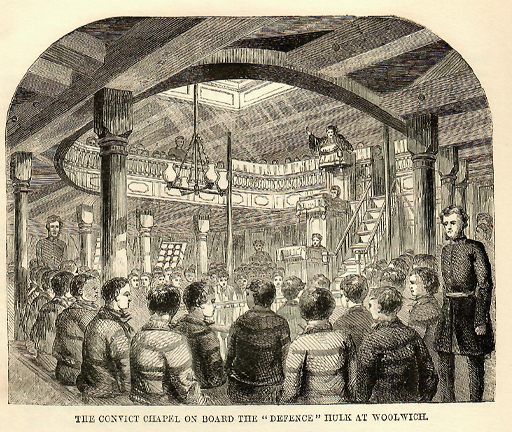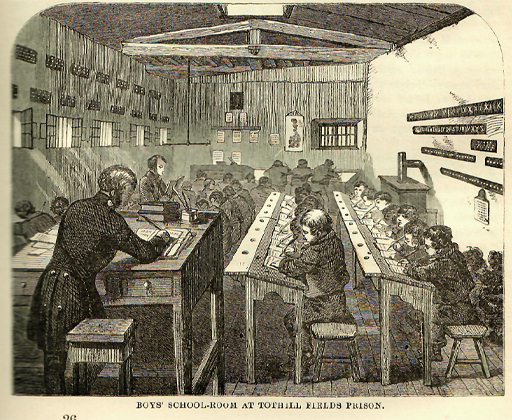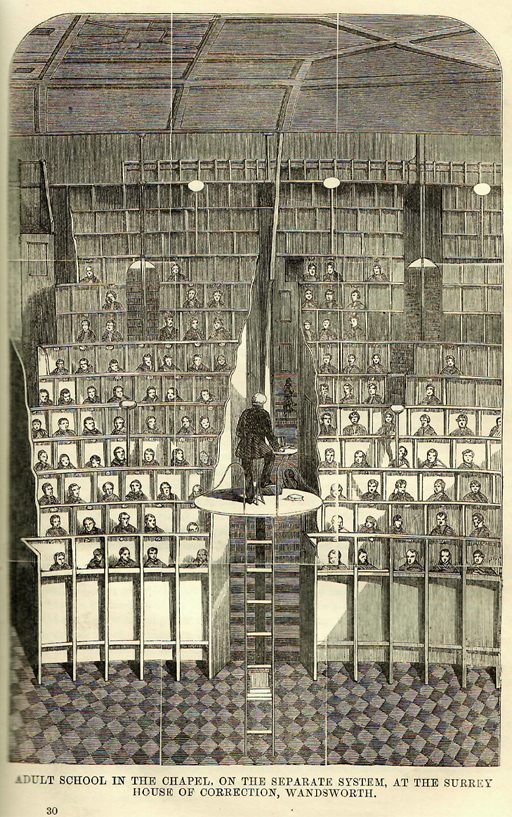5 Schoolrooms

Before the 1860s, even in prisons which had adopted the separate system, prisoners were mostly assembled together for instruction. This required space. In the early 1800s, instruction in reading and writing often took place in any available space within the prison. Between 1816 and 1850, convicts at Millbank took the stools from their cells and gathered in groups of sixteen in the corridor for lessons. Convicts on hulks congregated in spaces on the accommodation decks. In local prisons, dayrooms, wards and yards were used. The governor’s kitchen was used at Abingdon House of Correction in the 1830s. Some prisoners were taught at their place of work. At Bury St Edmunds County Gaol, men were taught next to the treadwheel during their rest intervals. At Maidstone County Gaol in 1837, the women were taught in the laundry.
These spaces were often unsuitable for education. The prisoners at York County Gaol were forced to use books for seats to protect against the cold of stone benches until wooden seating was introduced in 1842, while the dayrooms used at Leicester County House of Correction in 1842 were too hot for the schoolmaster to deliver a lesson. Therefore, from the 1830s, specially designated schoolrooms, either purpose-built or converted, began to appear in prisons (Crone, 2022, ch.3).
Activity 4 Designing schoolrooms for prisons
The following pictures (engravings) of prison schoolrooms date from the 1850s. Take a look at them now and jot down any distinguishing features. It might help to compare them – they are rather different!
Discussion
The boys’ schoolroom at the Tothill Fields House of Correction looks like a fairly typical elementary school classroom. The boys are seated at desks in rows. The desks are slanted with ink pots. There are various wall hangings, one of which looks like the letters of the alphabet. The only feature which suggests this schoolroom is in a prison are the bars on the windows. You might have also noticed the raised desk of the teacher which allows him to supervise the boys.
The school for adults at Wandsworth Prison – which was held in the chapel – looks completely different. Each prisoner is confined in a separate box in order to prevent any communication. The schoolmaster teaches from a raised platform so that all the prisoners can see him.
Wandsworth is an example of the kind of experimentation in schoolroom design which was encouraged by the separate system. Although the leading proponents of separation believed that prisoners should continue to assemble for school, there was a desire to limit physical contact as much as possible.
From 1837, partitions began to appear in schoolrooms and, after the construction of the model prison, Pentonville, in 1842, in chapels too. For convenience, partitioned chapels were often used as schoolrooms on weekdays. Far from preventing communication, partitions in schoolrooms and chapels encouraged prisoners to redouble their efforts. The boards separating prisoners became covered with graffiti and had to be stripped and cleaned regularly.


